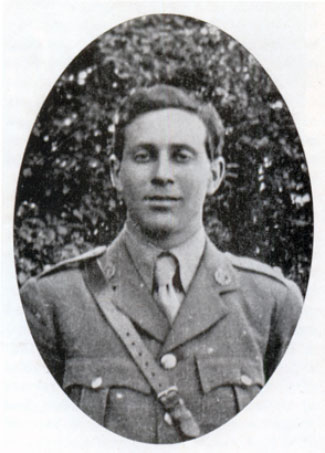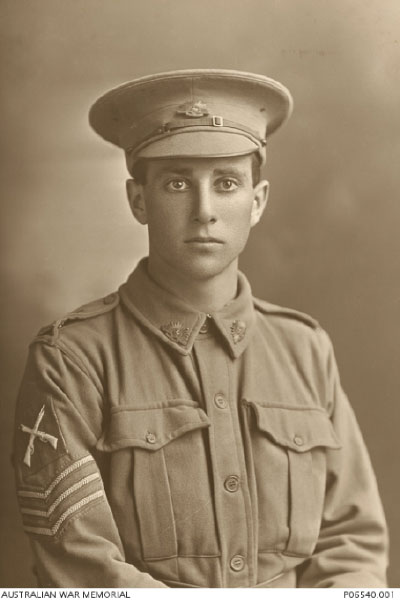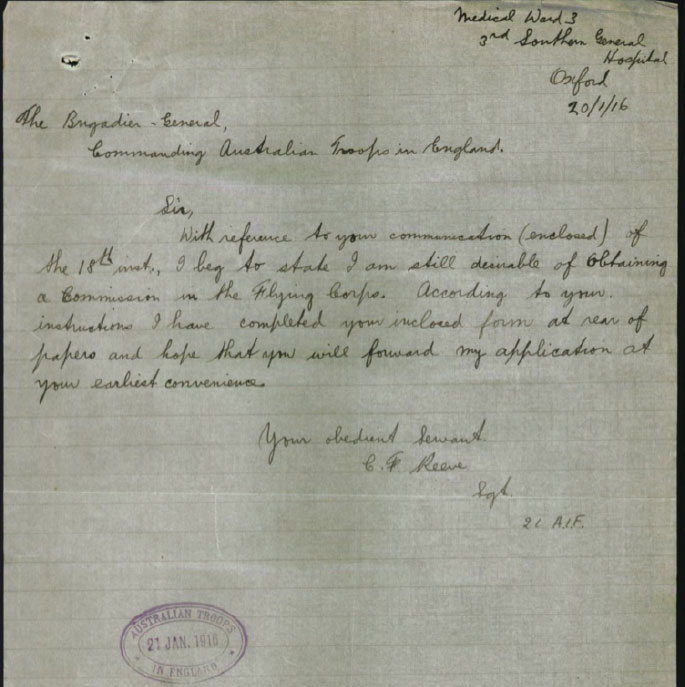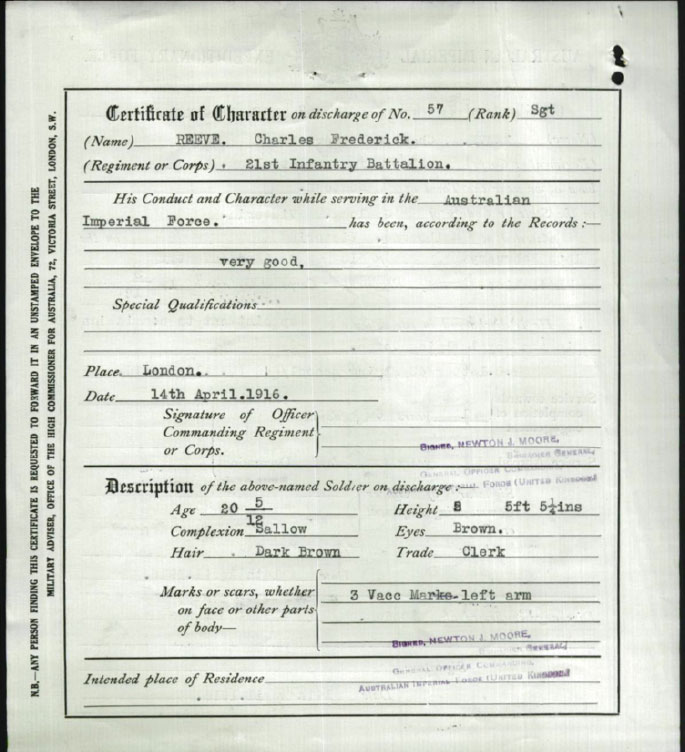War Memorial Hall c1929

Charles Frederick REEVE

Charles ‘Fred’ Reeve was born on 3 November 1895 in Geelong, Victoria. His parents were Charles Frederick and Annie (née Pirani) Reeve. He attended Scotch from 1906 to 1911. He had earlier attended Geelong College and later attended Caulfield Grammar.
Fred was a clerk when he enlisted on 15 February 1915 in Melbourne. He served in the 21st Battalion AIF and 2nd Squadron RFC with the ranks of Sergeant (AIF) and 2nd Lieutenant (RFC). His Regimental Number was 57.
Fred died on 13 May 1917 at Bethune, France. He was 21 years of age.
Service record
Fred Reeve enlisted at 19 years of age. He was initially allotted to the 22nd Battalion as a Sergeant, for he had already attained that rank in the pre-war militia. He was reverted to the ranks in August 1915, shortly before being transferred to the 21st Battalion. Like JD Burns and LT Adams, he was on the Southland when it sank.
After being rescued, he wrote to his mother:
‘… there were 1700 of us on the Southland steaming in company with five other boats, for the Dardanelles via Lemnos. We were within two and a half hours sail of Lemnos, about ten miles from any land, and fifteen miles from any other ship; when up comes a submarine and sends a torpedo right through us, just forward of the bridge - near the luggage hold. The torpedo exploded in the starboard coal bunker, it entered in the port (left) side, and blew up the deck. It made a terrible noise, and then the whistle blew and the boat stopped. We all ran to our stations and fell into line, and waited till our boats were ready. Some boats got down all right, and some upset; ours upset and I was struggling in the Mediterranean, with all my clothes, boots, and puttees on. I managed after a time to get into one of the life boats. We then attempted to row towards the distant land. This paper I am writing on was in my pocket, and is still damp. I took off my boots and puttees because I had no life belt, and as there was a heavy sea running, I was scared I might drown if we upset. Our chief aim was to get away from the Southland, as she was settling down, and in doing this we passed our Brigadier Colonel Linton who was floating quite still, with his life belt on. Four of us managed to pull him on board, and we just let him lie in the boat. We were so done and sick, and suffering so from shock, that we didn’t care what happened to who. After four and a half hours in the boat, we were picked up by a French destroyer, called the Mussue - I forgot to say that our wireless had called up several war boats and troopships - and this took us, about eighty of us, to Lemnos. The Brigadier died almost as soon as we got on the destroyer, so we covered him with a flag. When we got to Lemnos we were put on the boat on which I am now, the Transylvania, a huge boat, and gradually, all through the late afternoon and night boats kept on arriving with injured men on board. I suppose that there are about fifty men lost; but we don’t know yet. We had a marvellous escape, as the submarine fired two torpedoes, one missed us though. The gun on our stern fired at it, but I don’t think it was a hit. Our men behaved splendidly; but the ship’s crew were a disgrace. The ship’s captain shot two of his men dead, who left their posts. The Southland did not sink; but has been towed to Lemnos. I have only the clothes I stand in; but have lost my boots and puttees.’
Fred was subsequently on Gallipoli for five weeks until in October 1915 he sprained his back carrying ammunition and was evacuated. He went first to Lemnos and then to England, where in November he arrived at 3rd Southern General Hospital in Oxford. He also developed gall stones. The Scotch Collegian said that from the age of 13 Fred had been keen to be an aviator, and while recovering in England he sought to join the Royal Flying Corps. His service record contains various letters to AIF authorities in England asking them to help him (see an example below). On recovering in England he was discharged from the AIF on 14 April 1916 after obtaining a commission as a 2nd Lieutenant with the 2nd Squadron, Royal Flying Corps (see below for letter he received on being accepted). He crashed in fog in Scotland, destroying his aircraft and injuring himself. He returned to Australia but by November 1916 had recovered and returned to England and his squadron. From 1 May 1917 he was flying in France, where for the next 11 days he supposedly flew over enemy lines, ‘returning often with the wings of his plane riddled.’
His observer described an accident on 11 May: ‘He and I were detailed to do a contact patrol, and were just leaving the aerodrome when the machine, for no apparent reason, refused to answer its controls. Lieut. Reeve did everything possible to avoid disaster, but was unable to do so. We crashed into a tree, then a house. I found I was pinned under the wreckage, but for a slight cut on the head and a few cuts on the face, was unhurt…The doctor told me [Fred] might survive, but unfortunately he died on May 13th, without recovering consciousness.’ The observer noted that Fred and he were ‘great chums’, who had often flown together and that although Fred had been with the unit only a few days he was ‘a general favourite and always cheerful’. He emphasised that it was an accident not to be attributed to the man or the machine. He noted that Fred, after dying at 33rd Casualty Clearing Station, was buried near the aerodrome at Bethune.
Fred Reeve is buried in the Bethune Town Cemetery, France.
Photographs and Documents:

A studio portrait of Charles Reeve taken in Melbourne in 1915

Letter from Frederick Reeves asking for permission to leave the AIF so as to join the Royal Flying Corps.

Certificate of Character associated with Fred Reeve’s discharge before being transferred to the Royal Flying Corps

Instructions to Frederick Reeve after he was accepted into the RFC
Sources:
- Australian War Memorial – Roll of Honour and Red Cross Wounded and Missing file
- Heritage Guide to the Geelong College - http://gnet.geelongcollege.vic.edu.au:8080/wiki/REEVE-Frederick-Charles-1895-1917.ashx?HL=the
- Mishura Scotch Database
- National Archives of Australia – B2455, REEVE CHARLES FREDERICK
- Scotch Collegian 1917
- The AIF Project - https://www.aif.adfa.edu.au/showPerson?pid=251634


